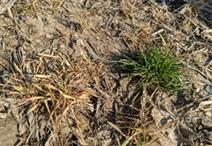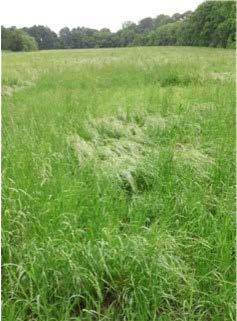Assessing Options for Italian Ryegrass Control Prior to Soybean Planting

Italian ryegrass is a winter annual weed that often needs to be managed prior to soybean planting. In Maryland, populations of Italian ryegrass have been confirmed to be resistant to group 1 (Axial, Select) and group 2 (Harmony, PowerFlex) herbicides, but recent populations have appeared to develop resistance to glyphosate (Figure 1). With limited herbicide options, preplant control of Italian ryegrass will be challenging for growers. In the fall of 2021 through spring of 2022, a study sponsored by the Maryland Soybean Board was conducted at a farm site in Talbot County, MD to evaluate different herbicides and application timings for controlling suspected herbicide-resistant Italian ryegrass. This study had two objectives: determine the optimum application timing and herbicides to control Italian ryegrass ahead of planting soybeans. Italian ryegrass seed will germinate in both the fall and the spring, therefore herbicide treatments were applied in the fall, spring, and in the fall followed by a second application in the spring. Herbicide selections consisted of glyphosate applied alone and glyphosate plus either clethodim (Select Max), flumioxazin (Valor), or saflufenacil (Sharpen). Valor and Sharpen can be applied preplant in both winter wheat and soybean to control many different weeds and Select Max is an herbicide that is used to control many annual and perennial grasses after they emerge.
Our results showed application timing and herbicide selection had a significant effect on Italian ryegrass control, density, and height, but there appeared to be no additional benefit when these two factors were combined. In the spring of 2022, Italian ryegrass density and height were lower with sequential herbicide treatments compared to single applications in the spring or fall (Table 1). This was reflected in improved control with sequential compared to single applications. With multiple germination periods, it is likely that two applications will be needed to provide better control of both early and late emerging Italian ryegrass.
| Application timing |
Control % |
Density Plants m⁻² |
Height cm |
|---|---|---|---|
| Fall | 44 b | 12 a | 20 a |
| Spring | 48 b | 16 a | 25 a |
| Sequential | 81 a | 4 b | 15 b |
ᵃ Means with the same letter do not differ significantly according to Fisher’s LSD (α = 0.05).

Italian ryegrass density and height were lower when Roundup was applied with Select Max compared to all other treatments, regardless of application timing (Table 2, next page). This was reflected in a significant improvement in control with this treatment; however, no treatment provided over 95% control. These results indicate this Italian ryegrass population to be glyphosate-resistant (Figure 2). Tank mixing glyphosate and other herbicides did not always improve control. Sharpen is a broadleaf-selective herbicide that is commonly used to help control glyphosate-resistant weeds like marestail, but it will not control Italian ryegrass. Although, Valor can provide residual control of this weed, including it with Roundup did not significantly improve control over Roundup plus Sharpen or Roundup alone. The combination of Roundup plus Select Max appeared to have a synergistic affect; however, previous research at this site showed Select Max alone provided no more than 30% control. Additional research is currently being conducted to evaluate the level of resistance to these different herbicide groups. Moving forward, additional strategies, including non-chemical ones, will likely be needed to manage this weed before planting soybeans and other summer crops in Maryland.
| Herbicide(s) | Group | Rate (fl oz a⁻¹) | Control % |
Density Plants m⁻² |
Height cm |
|---|---|---|---|---|---|
| Roundup | 9 | 36 | 38 b | 16 a | 25 a |
| Roundup + Select Max | 9 + 1 | 36 + 16 | 87 a | 2 b | 13 b |
| Roundup + Sharpen | 9 + 14 | 36 + 2 | 49 b | 16 a | 23 a |
| Roundup + Valor | 9 + 14 | 36 + 2 | 58 b | 12 a | 23 a |
ᵃ Means with the same letter do not differ significantly according to Fisher’s LSD (α = 0.05).
This article appears in November 2022, Volume 13, Issue 8 of the Agronomy news.
Agronomy News, November 2022, Vol. 13, Issue 8
Agronomy News is a statewide newsletter for farmers, consultants, researchers, and educators interested in grain and row crop forage production systems. This newsletter is published once a month during the growing season and will include topics pertinent to agronomic crop production. Subscribers will receive an email with the latest edition.
Subscribe